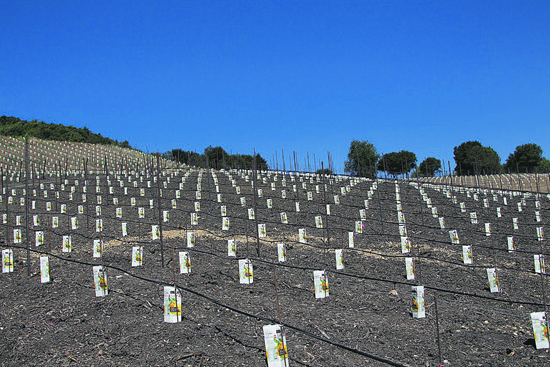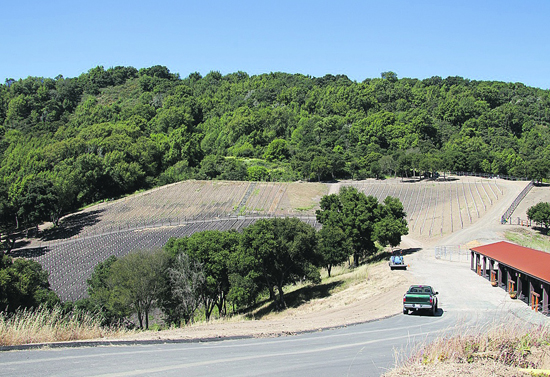| | Published July 6th, 2011
| Winemaking - the New Lamorinda Lifestyle
| | By Sophie Braccini |  | | Newly developed vineyard across from Rancho Laguna Park Photo Doug Kohen
|
Is there an American Viticultural Area (AVA) designation in the future of Lamorinda? A few years ago the Lamorinda Winegrowers Association (LWA) included people who grew grapes and dreamed about making their own wine. Today that dream is a reality with three bonded Lamorinda wineries, and several new vineyards in the ground or in preparation. Some of these vineyards are quite large and, because the project manager is Sal Captain of Captain Vineyards, they are being created using the Captains' concept of sustainable agriculture - according to Captain, it's just taking advantage of the unique characteristics of Lamorinda's soil and climate.
 "When I tested Salah's (Sal Captain's) Cabernet from a #196 root stock, the same as the Opus 1 Cabernet, I started to become very interested in becoming a winemaker myself," says Jamie Rector, "so when we bought 56 acres of unincorporated county land just across from Rancho Laguna Park in Moraga, I asked him to become a partner in developing some of that land."
"When I tested Salah's (Sal Captain's) Cabernet from a #196 root stock, the same as the Opus 1 Cabernet, I started to become very interested in becoming a winemaker myself," says Jamie Rector, "so when we bought 56 acres of unincorporated county land just across from Rancho Laguna Park in Moraga, I asked him to become a partner in developing some of that land."
 The Rectors used to be neighbors of the Captains, who have set their vineyard in the Bluffs area of Moraga; they witnessed how Sal and his wife Susan became professional winemakers over the years. "When Jamie asked me to help, the first thing we did was test the soil," says Captain, "it is a typical Moraga/Orinda soil made of clay loam with silt and sand stone, a perfect combination for a vineyard."
The Rectors used to be neighbors of the Captains, who have set their vineyard in the Bluffs area of Moraga; they witnessed how Sal and his wife Susan became professional winemakers over the years. "When Jamie asked me to help, the first thing we did was test the soil," says Captain, "it is a typical Moraga/Orinda soil made of clay loam with silt and sand stone, a perfect combination for a vineyard."
 Together they choose a 2.5 acre expanse with a good orientation and slant, and with the help of a GPS company to maximize sun positioning, Captain designed three contiguous areas on which to plant 3150 vines. "Most of it is planted with the #169 Cabernet Sauvignon rootstock that has produced some phenomenal Cab for us," adds Captain.
Together they choose a 2.5 acre expanse with a good orientation and slant, and with the help of a GPS company to maximize sun positioning, Captain designed three contiguous areas on which to plant 3150 vines. "Most of it is planted with the #169 Cabernet Sauvignon rootstock that has produced some phenomenal Cab for us," adds Captain.
 The cultivars were planted a few months ago and are already growing nicely. Two wells were drilled on the property. "We will train these plants the way we did on our property, to use less and less water over the years," says Captain. Last year, he watered his six- year-old vineyard only three times during the whole season. In addition to conserving water, Captain explains, "When you train the roots to grow deeper into the soil to get their water, the system expands and extracts a more diverse range of nutrients from the soil," he says, "the result is more complexity and better testing wine. And when people hear that we don't add anything to it, they like it even more."
The cultivars were planted a few months ago and are already growing nicely. Two wells were drilled on the property. "We will train these plants the way we did on our property, to use less and less water over the years," says Captain. Last year, he watered his six- year-old vineyard only three times during the whole season. In addition to conserving water, Captain explains, "When you train the roots to grow deeper into the soil to get their water, the system expands and extracts a more diverse range of nutrients from the soil," he says, "the result is more complexity and better testing wine. And when people hear that we don't add anything to it, they like it even more."
 "There is something very artistic and soothing looking at the vineyard," says Rector, "this is part of the pleasure of having it, along with seeing it grow from the start."
"There is something very artistic and soothing looking at the vineyard," says Rector, "this is part of the pleasure of having it, along with seeing it grow from the start."
 Paul Coletta, the owner of Humblebee Vineyard in Orinda, agrees that growing vines is a life-changing experience. "For me it is a lifestyle," says Coletta who also asked Caption to manage his new vineyard, "I love the people, the food and wine aspect of it, and the connection with nature." Coletta, along his wife Catherine and two children, started by installing bee hives on his property (thus the name of the vineyard), then added owl boxes to control gophers, and a solar energy system to power his future production. 200 plants of Syrah have already been planted and his planned addition of 300 more in the fall - Viognier and Mourvédre - will make him one of Orinda's largest growers. Paul Coletta, the owner of Humblebee Vineyard in Orinda, agrees that growing vines is a life-changing experience. "For me it is a lifestyle," says Coletta who also asked Caption to manage his new vineyard, "I love the people, the food and wine aspect of it, and the connection with nature." Coletta, along his wife Catherine and two children, started by installing bee hives on his property (thus the name of the vineyard), then added owl boxes to control gophers, and a solar energy system to power his future production. 200 plants of Syrah have already been planted and his planned addition of 300 more in the fall - Viognier and Mourvédre - will make him one of Orinda's largest growers.
 Captain's third vineyard management project is scheduled to go in the ground in the spring of 2012, and has the potential of becoming the largest and most visible Lamorinda vineyard. The 22 acres bought last winter by Andrea Wood form the hill that faces the Rheem Center and parallels Rheem Boulevard. It used to be a buffalo ranch and Wood, who lives in Orinda, wants to cover the entire hill with vines.
Captain's third vineyard management project is scheduled to go in the ground in the spring of 2012, and has the potential of becoming the largest and most visible Lamorinda vineyard. The 22 acres bought last winter by Andrea Wood form the hill that faces the Rheem Center and parallels Rheem Boulevard. It used to be a buffalo ranch and Wood, who lives in Orinda, wants to cover the entire hill with vines.
 "Initially, we will plant 10 acres (about 12,000 vines) with Cabernet Sauvignon and Sal (Captain) will do it," says the self-assured young woman who has already planted 100 manzanita olive trees on the property with the intent to produce olive oil. Her objective is to have her own label, Packwood Vineyard, named after her late husband. "This project will put Lamorinda wines on the map," believes Wood, "and it has to be the highest quality, as well as sustainable."
"Initially, we will plant 10 acres (about 12,000 vines) with Cabernet Sauvignon and Sal (Captain) will do it," says the self-assured young woman who has already planted 100 manzanita olive trees on the property with the intent to produce olive oil. Her objective is to have her own label, Packwood Vineyard, named after her late husband. "This project will put Lamorinda wines on the map," believes Wood, "and it has to be the highest quality, as well as sustainable."
 American Viticultural Areas (AVA), designated by the federal government to highlight wine areas of special significance, are typically 1,000 acres or larger. The smallest AVA in the US is the Cole Ranch AVA in Mendocino County with 189 acres, with 55 under vine (2007). The specificity of Cole Ranch is its relatively cold micro-climate, which gives its wines distinctly different characteristics than those from surrounding areas.
American Viticultural Areas (AVA), designated by the federal government to highlight wine areas of special significance, are typically 1,000 acres or larger. The smallest AVA in the US is the Cole Ranch AVA in Mendocino County with 189 acres, with 55 under vine (2007). The specificity of Cole Ranch is its relatively cold micro-climate, which gives its wines distinctly different characteristics than those from surrounding areas.

|
 | | Over 3000 vines have been planted. Photo Doug Kohen
|  | | The vineyard plots were oriented to optimize sun positioning with the help of a GPS company. Photo Doug Kohen
| | | | | | | | | Advertisement | | |
| | | print story
Before you print this article, please remember that it will remain in our archive for you to visit anytime.
download pdf
(use the pdf document for best printing results!) | | | Comments | | |
| | | | | | | | | | | | | | | | |




